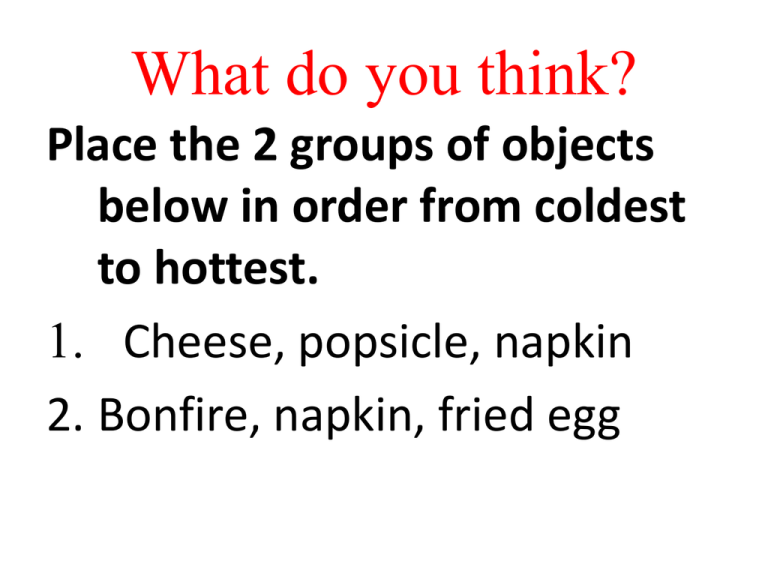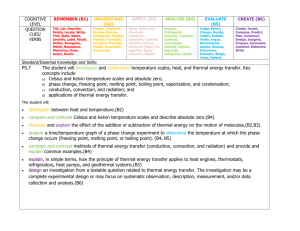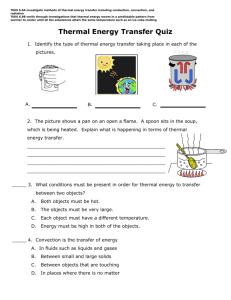melting point
advertisement

What do you think? Place the 2 groups of objects below in order from coldest to hottest. 1. Cheese, popsicle, napkin 2. Bonfire, napkin, fried egg So… • Is the napkin hot or cold? (Chapter Eleven) Temperature, Phases of Matter and Heat Back to the hot and cold … • Using the words “hot” or “cold” can sometimes be confusing…or relative (some of you think the room is too cold…some don’t) • To reduce confusion, an object should be described by its temperature. • SUBJECTIVE vs OBJECTIVE Temperature • Is a measure of the kinetic energy of the particles in an object. • The faster the particles move, the higher the temperature • Temperature is independent of the amount of the substance being measured (a little bit can have the same temperature as a whole bunch) Temperature There are two common temperature scales. The Celsius scale: Water freezes at 0 C Water boils at 100 C (metric) On the Fahrenheit scale: Water freezes at 32 F Water boils at 212 F. (English or standard) The rd 3 Temperature Scale (though not so common) • Kelvin (K) – SI unit – starts at absolute zero • NO degrees, labelled in “Kelvins” • Fahrenheit (oF) – US unit • Celsius (oC) – metric unit – broken into 100 equal units between freezing and boiling water Absolute zero Absolute zero is -273°C. You cannot have a temperature lower than absolute zero. Think of absolute zero as the temperature at which atoms are “frozen.” Thermometer A thermometer is an instrument that measures temperature Thermometers you have likely seen uses colored liquid alcohol to sense temperature- because alcohol stays liquid over a wide range of temperatures. How does a thermometer work? • They work due to thermal expansion • As a substance gets hotter, its particles move faster. The particles do not expand, but they need to spread out…this spreading is called thermal expansion. • When the thermometer is warmed, the liquid inside expands and rises up in the tube. Thermal Expansion 1. object is heated up 2. particle movement increases 3. particles spread out Thermal Contraction 1. object cools down 2. particle movement decreases 3. Particles stay closer together. Converting to Kelvin The Kelvin temperature scale is useful in science because it starts at absolute zero. To convert from Celsius to Kelvin, you add 273 to the temperature in Celsius Let’s convert... • What temperature was it this morning when you got up? • Let’s convert it to Celcius: Another temperature conversion… • Look at the conversion formulas earlier in your notes. • It is 77 in this room. • What unit would that be in? • Let’s convert that number to the other 2 units. What temperature really is… Temperature measures the kinetic energy per atom due to random motion. (how fast the molecules are moving) What temperature really is… The back-and-forth jiggling of atoms is caused by thermal energy, which is a kind of kinetic energy- (E an object possesses due to temperature) BROWNIAN MOTION. Atoms are in constant motion, even in a solid object. More on temperature (without having to listen to me)! 1. Watch “Brainpop” on Temperature 2. Take review quiz on Temp. Tell your neighbor! 1.) Why can’t there be a temperature lower than absolute zero? 2.) Explain the scientific meaning of the word random. 3.) Which is colder, 0 ˚C or 20 ˚F ? More tomorrow… What is heat? • Heat is energy of the atom that is moving. • Heat flows any time there is a difference in temperature. • Because your hand has more thermal energy than the chocolate, thermal energy flows from your hand to the chocolate and the chocolate begins to melt. Soda and Heat • How does soda get cold in a cooler of ice? What is Thermal Energy • Remember, temperature is the measure of particle movement due to temperature )(kinetic energy)…..however, the TOTAL energy in ALL of the particles in a substance is called its thermal energy…. • the more particles there are, the more thermal energy it contains. What is Temperature again? Heat, Temperature, and Thermal Energy • Heat, temperature, and thermal energy are related, but are not the same thing. • The amount of thermal energy depends on the temperature but it also depends on the amount of matter you have. HEAT TEMPERATURE and THERMAL ENERGY Units of heat and thermal energy • The metric unit for measuring heat is the joule. • This is the same joule used to measure all forms of energy, not just heat. How are calories related to heat? • How can you determine how much “energy” is contained in a substance? • Use a calorimeter. It uses the amount of heat generated by burning something as a measure of how much energy it contains. Heat and thermal energy • Thermal energy is often measured in calories. • One calorie is the amount of energy it takes to raise the temperature of one milliliter of water by one degree Celsius. How a calorimeter works: 1. Food to be tested is burned below a container of water. 2. The temperature increase in the water is measured. 3. A calorie is the amount of energy needed to change the temp 1 gram of water by 1oC. Heat Transfer There are three ways that heat is transferred: 1. Thermal Conduction 2. Convection 3. Thermal Radiation Thermal Conduction Heat conduction is the transfer of heat by the direct contact of particles of matter. Conduction occurs between two materials at different temperatures when they are touching each other. Where is the heat energy conducted to and from in this system? Examples of Conduction • direct contact Thermal conductors and insulators • Materials that conduct heat easily are called thermal conductors and those that conduct heat poorly are called thermal insulators. Is a down coat a conductor or an insulator? • Substances that transfer heat easily are called conductors • The best conductors are metals. • Substances that do not conduct thermal energy very well are called insulators. Application • For years, the plumbing in homes was done in copper piping. Now they are done in PVC. What are some reasons that this change occurred? Convection • Convection is the transfer of heat through the motion of matter such as air and water. • In a container, warmer fluid rises to the top and cooler fluid sinks to the bottom. • This is called natural convection. Convection Convection • Convection is mainly what distributes heat throughout a room. Radiation • Transfer of heat through electromagnetic waves across empty space. Thermal radiation • Heat from the Sun is transferred to Earth by thermal radiation. • The higher the temperature of an object, the more thermal radiation it emits. • All the energy the Earth receives from the Sun comes from thermal radiation. Thermal radiation • Thermal radiation is also absorbed by objects. • The amount of thermal radiation absorbed depends on the surface of a material. • Dark surfaces absorb most of the thermal radiation they receive. • Silver or mirrored surfaces reflect thermal radiation Equilibrium • Thermal equilibrium occurs when two bodies have the same temperature. • No heat flows in thermal equilibrium because the temperature is the same in the two materials. I remember that! 1.) What are the three ways heat is transferred? 2.) Heat from the Sun is transferred by _______ _________. 3.) When heat is transferred by two objects touching, it is called _____________. HEAT TRANSFER VENN DIAGRAM STATES OF MATTER Solid Liquid Gas AND ????? The Phases of Matter Intermolecular forces tend to bring molecules together. Intermolecular forces have to be overcome in order to change phase. Sing it Baby…. http://www.youtube.com/watch?v=btGu9FWSPtc Solid A solid holds its shape and does not flow. The molecules in a solid vibrate in place, but on average, don’t move far from their places Liquid A liquid holds its volume, but does not hold its shape—it flows. Liquids flow because the molecules can move around. Gas A gas flows like a liquid, but can also expand or contract to fill a container. A gas does not hold its volume. The molecules in a gas have enough energy to completely break away from each other. Plasma • At temperatures greater than 10,000˚C, the atoms start to come apart and become a plasma. • Atoms are broken apart into separate positive ions and negative electrons • Conducts electricity and is formed in lightening and inside stars. I remember that! 1.) What are the three phases of matter? 2.) Liquid holds its volume, but does not hold its ___________ . 3.) The melting point and the freezing point for water is ___ degrees Celsius. Phases of Matter http://www.youtube.com/watch?v=KxtqzApPAfc 9:12 Phases of Matter and Phase Change • • • • • • Boiling point Melting point Freezing point Vaporization/evaporation Condensation Phase Change Diagram Boiling Point The temperature at which a liquid becomes a gas is called the boiling point. Vaporizaton and Evaporation • Also known as the boiling point • When liquid turns to vapor (gas) Melting Point The melting point is the temperature at which a substance changes from a solid to a liquid. Freezing Point The freezing point is the temperature at which a substance changes from a liquid to a solid. Condensation Condensation is the point at which a substance changes from a gas to a liquid. Melting and boiling points of common substances Materials have a wide range of melting and boiling points. So what? • So what really is the difference between the boiling point and the condensation point of a substance? • So what really is the difference between the freezing point and the melting point of a substance? Phase Change Diagram DO NOW: Quick Quiz – True/False 1. Heat is the transfer of energy between two objects with different temperatures. 2. Conduction occurs in fluids. 3. Convection currents result from temperature differences in gases and liquids. 4. Radiation is the means by which the energy from the sun is transferred to Earth.







